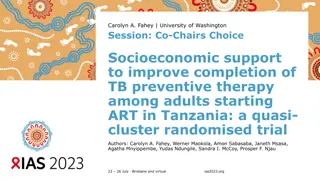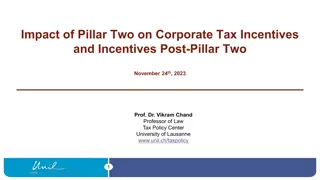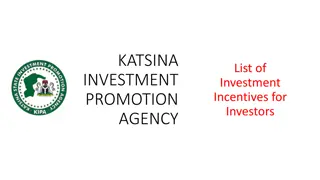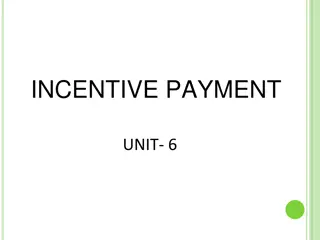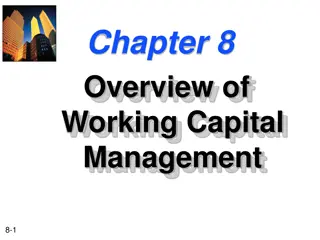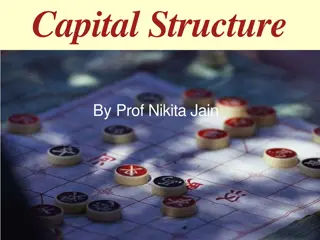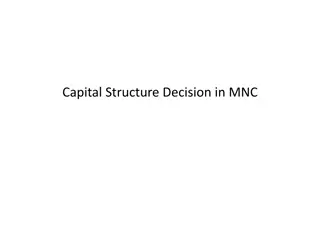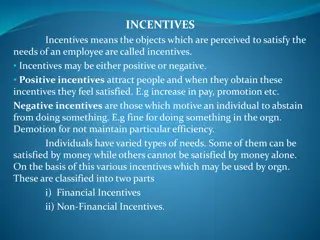Understanding Capital Structure, Stockholder Incentives, and Risk-Taking in Financial Decision-Making
Explore the impact of capital structure on stockholder incentives such as risk-taking, short-term focus, underinvestment, and excessive dividends. Dive into scenarios illustrating leverage, credit rationing, and firm liquidation decisions. Delve into a case study of Baxter, Inc., facing financial distress and considering a risky strategy that could lead to varying outcomes for equity holders. Understand how debt introduces incentives for firms to take excessive risks in different scenarios.
Download Presentation

Please find below an Image/Link to download the presentation.
The content on the website is provided AS IS for your information and personal use only. It may not be sold, licensed, or shared on other websites without obtaining consent from the author. Download presentation by click this link. If you encounter any issues during the download, it is possible that the publisher has removed the file from their server.
E N D
Presentation Transcript
Capital Structure and Stockholder Incentives P.V. Viswanath Financial Theory and Strategic Decision-Making
Outline Shareholder incentives to increase risk Incentives to focus on the short-run Incentives to underinvest Incentives to pay excessive dividends Impact on access to debt and equity capital Impact on the liquidation decision incentives to keep a firm intact when it should be liquidated.
Leverage and Risk We first look at the incentives for levered firms to take excessive risk. This also leads to a phenomenon called credit rationing, as well as managerial unwillingness to liquidate the firm. We will look at three examples; in the first two, the firm will not need to invest additional resources. In the first example, one of the options is to do nothing; in the second example, the firm has to choose between two alternate projects.
Investing in Risky Assets Consider Baxter, Inc., which is facing financial distress. Baxter has a loan of $1 million due at the end of the year. Without a change in its strategy, the market value of its assets will be only $900,000 at that time, and Baxter will default on its debt. Baxter is considering a new strategy The new strategy requires no upfront investment, but it has only a 50% chance of success. If the new strategy succeeds, it will increase the value of the firm s assets to $1.3 million. If the new strategy fails, the value of the firm s assets will fall to $300,000. The expected value of the firm s assets under the new strategy is $800,000, a decline of $100,000 from the old strategy. 50% $1.3 million + 50% $300,000 = $800,000 4
Investing in Risky Assets If Baxter does nothing, it will ultimately default and equity holders will get nothing with certainty. Equity holders have nothing to lose if Baxter tries the risky strategy. If the strategy succeeds, equity holders will receive $300,000 after paying off the debt. Given a 50% chance of success, the equity holders expected payoff is $150,000. The perverse incentives for Baxter s shareholders to undertake the new strategy can be seen in the following table. 5
Leverage and excessive risk-taking: I The existence of debt introduces incentives for the firm to take excessive risk. Example: Consider these two projects faced by a firm with a promised payment of $500,000 to debtholders. There are only two possible states of the world, both equally likely.
Leverage and excessive risk-taking: II Payoffs to the two projects Prob. Proj. 1 Proj. 2 State 1 0.5 $600,000 $1,000,000 State 2 0.5 $600,000 $0 Expected Value $600,000 $500,000 Proj. 1 is better for the entire firm
Leverage and excessive risk-taking: III Payoffs to the bondholders Prob. Proj. 1 Proj. 2 State 1 0.5 $500,000 $500,000 State 2 0.5 $500,000 $0 Expected Value $500,000 $250,000 Proj. 1 is better for bondholders
Leverage and excessive risk-taking: IV Payoffs to the equityholders Prob. Proj. 1 0.5 $100,000 0.5 $100,000 Expected Value Proj. 2 $500,000 $0 $250,000 State 1 State 2 $100,000 Proj. 2 is better for equityholders; the reason for the bad choice is that bondholders do not share in the upside but share in the downside. Until now, we did not require investment by the firm; the next project requires investment by the firm and looks at the implications.
Excessive Risk-Taking and Internal Resources Until now, we did not require investment by the firm; the next example requires investment by the firm and looks at the implications. In the next example, the project requires a $70m investment. Some of it will be sought from outside investors and some of it will be taken from retained earnings. We arbitrarily consider what the firm s choice will look like if, of the required $70m., the firm issues debt with a face value of $40m.
Excessive risk-taking and Internal Resources Exhibit 16.3: Unistar s Alternative Payoffs on a project requiring $70m investment Exhibit 16.4: Unistar s Payoffs to Equity Holders When the Debt Obligation Is $40 Million
Excessive risk-taking and internal resources If equityholders can commit to taking process 1, debtholders would be willing to invest $40m for a promised payoff of $40m, because then they would be repaid with certainty. Equityholders would put up $30m. and obtain a $5m. profit. However, this will involve covenants and monitoring, which may not be feasible. If so, debtholders would only put up $32.5m for a promised payment of $40m. Then, they would get (40+25)/2 = $32.5m. But then equityholders would have to put up the remaining $37.50m for a payoff of only $35m under project 1 and $37.5m under project 2. They would take project 2 and lose the NPV from project 1. However, if the firm had $45m. in cash, it would only have to raise $25, which it could at an interest rate of 0% and then equityholders would choose project 1 and obtain the higher value from project 1.
Excessive risk-taking and internal resources first number is bondholder payoff; second number is stockholder payoff Stockholders Bondholders assume stockholders will choose Proj. 1 0,5 Proj. 2 7.5, -2.5 choose Project 1 Project 2 -7.5,7.5 0,0 It is optimal for stockholders to choose project 2, independent of bondholder assumption. Once this is given, bondholders will price the bond, assuming stockholders choose project 2. Hence not having sufficient internal resources can be costly!
Credit Rationing We have seen that when a firm s debt obligations increase, it has a greater tendency to choose risky projects. Consequently, it makes sense that when interest rates increase, as well, firms tend to choose riskier projects. In other words, higher interest rates may not be able to compensate for the firm s ever-increasing tendency to choose risky projects. Hence lenders may choose not to lend to certain firms regardless of the rate of interest the firms are willing to pay.
Credit Rationing Exhibit 16.5: Multi-Universal s Project Payoffs on a $100m investment We assume that investors are risk neutral and that the risk-free rate of interest is zero. The amount borrowed is $100m. The present value of project A is 130(.8) + 50(.2) = 114. The present value of project B is 150(.2) + 50(.8) = 70, i.e. an NPV < 0 at any positive interest rate. So we would want project A chosen over project B; however, we will see that stockholder s choice of project changes when the rate of interest changes.
Credit Rationing The riskfree rate of return on the $100m debt is 0%. In this case, the promised rate of interest will be 12.5%, assuming that project A will be chosen. Project A Payoff to project 130 Payoff to bondholders 112.5 Payoff to equityholders 17.5 Good State Bad State 50 50 0 Exp Payoff 114 100 14 Even if the equityholders decide to consider project B, they will find it inferior to project A. Project B Payoff to project 150 Payoff to bondholders 112.5 Payoff to equityholders 37.5 Good State Bad State 50 50 0 Exp Payoff 70 62.5 7.5
Credit Rationing Now suppose the risk-free rate of return is 12%. If investors believe project A will be chosen, the promised interest rate will be 27.5%. But then equity holders will find it optimal to choose project B. Project A Payoff to proj 130 Payoff to bondholders 127.5 Payoff to equityholders 2.5 Good State Bad State 50 50 0 Exp Payoff 114 112 2 Project B Payoff to proj 150 Payoff to bondholders 127.5 Payoff to equityholders 22.5 Good State Bad State 50 50 0 Exp Payoff 70 65.5 4.5
Credit Rationing As a result, the lenders will have to demand an interest rate of 260%. But this would not be affordable, since project B has a negative NPV to begin with! Hence lenders will not be willing to lend at any interest rate! Project B Payoff to proj. 150 Reqd. payoff to bondholders 360 Payoff to equityholders 0 Good State Bad State 50 50 0 Exp Payoff 114 112 0
Capital Structure and Liquidation Equity holders are residual claimants and are paid after bondholders get paid. Hence they can be thought of as having a call option on the assets of the firm, where the exercise price is the face value of debt. Just as the value of an option is increasing in the volatility of the returns on the underlying asset, so too the value of equity is increasing in the volatility of returns on the assets of the firm. Compared to the payoff from continuing to operate, liquidation provides a relatively safe payoff. Hence equityholders prefer to keep the firm going, compared to liquidating it. Managers as representatives of equityholders also have this preference. Furthermore, the human capital of managers is often tied up with the continued existence of the firm. For all of these reasons, leveraged firms are less likely to liquidate.
The impact of existing debt-holder rights We now look at situations where the existing debt causes equity-holders to take suboptimal decisions because the benefit of the optimal decision at hand would go to the existing debt- holders, thus providing shareholders with a disincentive to take the optimal action. This includes shareholder myopia, the underinvestment problem, the debt overhang problem and the cashing out problem.
Short-sighted investment problem: Summary The existence of debt can lead shareholder value maximizing managers to take a short-sighted approach to investment. If the cashflows from a project are higher in the short-run, it might be preferred by shareholders if debt comes due in the short-run. Given information asymmetry, it may not be easy for the debt to be rolled over. The higher-NPV long-term project may not be liquid or tradable in the short-run. Opting for the long-term project may then lead to bankruptcy and loss of shareholder value. Here s a numerical example of this phenomenon.
Short-sighted investment problem Exhibit 16.2: Applied Textronics Cash Flows We assume the riskfree rate is zero. Then the long-term project value exceeds that of the short-term project. But: If the firm selects the short-term project, it will have enough funds to meet the debt payment due in year 1. It will default in the unfavorable state in year 2. Equityholders will get $20 in the favorable state and zero in the unfavorable state. If the firm selects the long-term project, it will not have enough funds and will have to refinance $30m. However, if the new debt is junior to the existing debt, the firm will have to promise $50 (since it will only be able to pay $10m in the unfavorable state). The payoffs to equityholders will be zero in the unfavorable state and $10m in the favorable state, if it takes the long-term project. Hence equityholders will choose the short-term project.
Short-sighted investment problem Some questions: We can see that the firm will not be bankrupt even if it takes the long-term project because the value of the project plus existing assets is $40m + $20m from the long-term project and 50 + (60+10)/2 from existing assets for a total of $145m., while the face value of liabilities are $140m. If so, why are we considering additional debt? Why not consider additional equity, which the firm could also raise, given that it is not bankrupt? Would that then lead the firm to pick the long-term project? Why issue junior debt? Why might there be a covenant preventing the firm from raising new debt with equal seniority to existing debt? What if the firm could issue such debt? Would the firm then end up choosing the long-term project?
Dispossessing bondholders Equityholders can potentially expropriate bondholders by issuing more debt. This is obviously true if the new debt is senior to the existing debt. But it is sometimes possible even if the new debt is of equal seniority, as the following example shows. Suppose the cashflows in the good state are 2500 and 800 in the bad state. Suppose there is debt with a face value of 1000. The equityholders will get an average payoff of $750. Bondholders will get (1000+800) or $900 on average. Now suppose equityholders issue debt worth 1000, promise to pay 70% and pay the $1000 as dividends. Equityholders will be better off, of course; they will get $1000. What about the new bondholders? They will have debt with a face value of 1700 and so will get [1700/(2700)]x2500 or $1574 in the good state and [1700/(2700)]x800 or $504 in the bad state for an average payoff of $1038.89 or 3.89%. So they might go for the deal.
Dispossessing bondholders Where s this money coming from? Existing bondholders get [1000/(2700)]x2500 or $926 in the good state and [1000/(2700)]x800 or $296 in the bad state for an average payoff of $611 compared to the average payoff of $900 previously. Hence by issuing debt of equal seniority, both equityholders and the new bondholders do better by dispossessing the existing bondholders. In this example, the equityholders used the new money raised to pay themselves dividends. What if they had used the money to invest in new profitable projects? Obviously, in such a case, the existing bondholders would be potentially better off (but not always). As a result, bondholders do not, typically, restrict companies from raising new debt of equal seniority; however, they often put in a negative pledge clause restricting the firm from issuing new debt that might reduce the security of the current lender. For example, issuing debt that is senior to the current debt.
The Underinvestment Problem Consider a firm that currently has debt with face value of $1000 that will come due in one year and assets that are projected to be worth $900 in one year. Suppose the firm has the opportunity to invest in a new project requiring an immediate investment of $100 and offering a return of 50% in one year. Assuming the required rate of return for this project is less than 50%, it s a NPV>0 project. 26
The Underinvestment Problem Suppose the only way to get the $100 for the initial investment is for the existing equity holders to contribute it. With the new project, equity-holders will get $50 in one year for a current investment of $100 clearly equity-holders would not make the investment even though the project has an NPV > 0. This is the Underinvestment Problem. This problem is also similar to another problem called the debt overhang problem where the existence of debt in a firm that s close to financial distress inhibits additional borrowing and investment. 27
Debt Overhang Consider a firm with $4000 of principal and interest payments due at the end of the year. (e.g. if we assume $3200 lent at 25% stated. Assume also a riskfree rate of 18% with the higher stated interest rate due to the perceived risk at the time of the debt issue.) If there is a recession, it will be pulled into bankruptcy because its cash flows will be only $2400. Else, it will have cash flows of $5000. The firm could avoid bankruptcy in a recession by raising new equity to invest in a new project (soon after beginning). The project costs $1000 and brings in $1400 in the boom state and $1200 in the recession state and has an NPV > 0 (if we use an 18% discount rate). Recession and Boom states are equally likely. Will it do the right thing and raise new equity funds? 28
No equity solution Firm Without Proj Firm With Proj Boom Recession Boom Recession 5000 2400 Firm Cashflows Bondholders payoff 6400 3600 4000 2400 4000 3600 Stockholders claim 1000 0 2400 0 The new project will not be undertaken. Stockholders have on av. $500 without the project, and $200 with the project [(2400)/2 1000].
And maybe no junior debt solution Firm W/o Proj Boom Recesn Boom Firm Cashflows Bondholders payoff New Jr. bondholders Stockholders claim Equityholders won t want to borrow money on the original terms either; it still won t be worthwhile. *The bondholders payoff assumes that the additional $1000 is raised as junior debt. Hence it will be paid only in the boom situation and so the payoff in that situation will have to be double the required payoff. Firm W/ Proj Recesn 3600 5000 2400 6400 4000 2400 4000 3600 0 0 2360 0 1000 0 40 0
Senior Debt/Project Financing Firm W/o Proj Boom Recesn Firm Cashflows New Sr Bondholder Jr Bondholder 4000 2400 Firm With Project Boom 6400 Recesn 3600 5000 2400 0 0 1180 1180 4000 2420 1000 0 1220 0 Stockholder We assume that the money can be raised as senior debt, to be paid prior to the claims of existing bondholders. It is assumed that these bondholders are willing to accept a return of 18%, since this debt is now riskfree. Note that junior bondholders are also better off with the project than without the project, as are equityholders.
Debt Overhang: Loan Commitments We saw that issuing senior debt would solve the problem. Two stage financing structured as a loan commitment can also be a solution. Fee = $150 plus 120 5/16% of draw-down. Tot Ret for bondholders (w/proj) = [0.5(5203.125)+0.5(3600)]/4200=4.8% Tot Ret for bondholders (w/out proj) = [0.5(4000)+0.5(2400)]/3200=0.00% However, the bondholders get 20 5/16% on the new investment. Firm W/o Proj Boom Firm W/ Proj Boom Recess n Recess n Firm Cashflows Bondholders 5000 4000 + 150 2400 2400 6400 5203.125 4150+(1000 x 1.203125) 1196.875 3600 3600 Stockholders 850 0 0
Loan Commitments This technique works because part of the payoff is independent of the amount borrowed. This allows the interest rate to be smaller if there is a new project. Effectively the lenders have been paid upfront. As a result, the disincentive to borrow isn t as large, when a good project turns up. In our previous example, the interest rate on the new borrowing is 20.3125%; presumably, a new lender would require a higher interest rate because s/he would be sharing the returns from the new investment with the existing bondholders who would have contributed nothing to the new project and would still be benefiting. As we saw before, junior bondholders would not put up the money. With this method, we are getting existing bondholders to put up the new financing. Since they are the ones benefiting from the new project, the debt overhang problem no longer exists. Here s another example of debt overhang.
Debt Overhang: Lily Pharmaceuticals Research
Debt Overhang: Lily Pharmaceuticals Research Assume a risk-free rate of zero and risk-neutral investors. Investors will be willing to invest $100 for a 10/11 chance of $110. At year 1, if the market is unfavorable, and the firm invests an additional $100m, the marketing rights can be sold for $150 at year 2. If not, the project will become worthless. However, given the existing debt, it will not be possible to raise the $100m if the market is unfavorable, since the new debtholders will not be paid in full. This is true even though the new $100m investment has a 50% return! The existing debt makes the new investment infeasible.
Debt Overhang: Senior Debt One Solution: Suppose the new project could be financed separately, say, under debtor- in-possession financing, or a new issue that would be senior to the previous issue (at, say, 10.5%). Then, the new project would be undertaken; and bondholders would be better off.
Cashing Out When a firm faces financial distress, we can also see the converse of the underinvestment problem. Stockholders have an incentive to take money out of the firm to cash out by paying themselves high dividends. Furthermore, if it is likely the company will default, the firm may sell assets below market value and use the funds to pay an immediate cash dividend to the shareholders. 37







